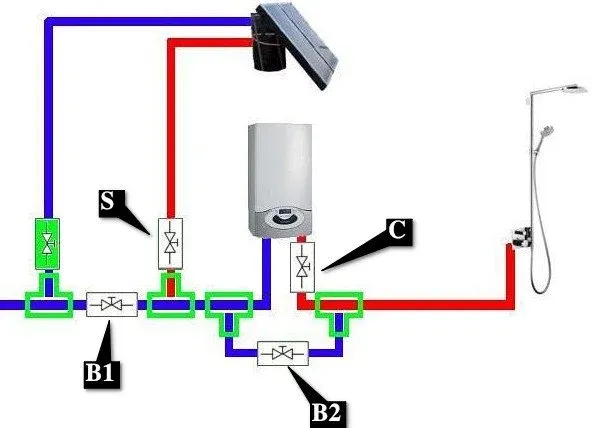
This is the home installation without modifications.
I will explain it graphically.
This is the typical installation to consume water heated by an auxiliary heater (gas or electric)
This installation makes the solar water (the one that comes hot from the ACS installation) pass through the heater.
It really gives you the possibility of increasing the temperature of the water that is already hot or warm from the solar tank.
It is a very good option when there is little sun or in a period of scarce solar radiation.
The drawback in this type of installation is that gas heaters have a very narrow coil, and this can reduce the pressure and flow of our tank if it lacks good pressure or is an inertia/gravity tank.
This installation should not be applied to an electric heater, or at least it would not be logical from a functional point of view since an electric heater is not a flow heater.
However, an electric heater CAN benefit from a warm water inlet, and thus obtain a direct benefit from not having to heat the new water inlet, but this would obviously be a totally different point of view.
Connecting the solar heater, with a 3-way valve to switch the flow to the heater or directly to the taps.
It is a very good option for simplified installation.
We can use this 3-way valve to switch and temporarily disable the heater (for sunny days), or we can have the valve pass solar water through the heater (when the solar water is only warm or cold)
It would be ideal to automate this switching.
If we cannot get the 3-way valve, we can use the 3-way valve to switch the water through the heater. We can also install it with 2 normal stopcocks, opening and closing each one depending on the desired use. (As described in the following title)
This installation can be perfectly applied with an electric water heater with the same functionality.
It has the same functionality as the previous case, but using normal stopcocks instead of 3-way valves.
The "S" key represents the stopcock for the water coming from the solar or ACS installation. (Tank outlet)
The "C" key represents the water heater outlet.
The "B1" key represents the water heater outlet that acts as a bypass or bridge to connect or isolate the solar thermal installation with the house
The "B2" key represents the water heater outlet that acts as a bypass or bridge to connect or isolate the auxiliary heater with the house
The bypass or bridge key will be used to facilitate the water's direct passage without going through the auxiliary heater.
Quick and easy explanation.
We are in the middle of summer where we do not need to use the auxiliary heater at all.
Open keys: S, B2.
This combination makes the hot water supply come directly from the solar heater tank, without entering or leaving the auxiliary heater.
Our solar installation does not contain hot water, either because it is stopped, under construction, or simply because a storm has not contributed to this.
We close key S, open key C, and close key B.
With this combination of keys we make the hot water supply circulate only and exclusively through the auxiliary heater.
We are in a situation where the water in the solar installation tank is hot, but not hot enough for our comfort level.
This situation can easily occur on some stormy days or at the end of winter or beginning of spring.
We open taps S and C, but close tap B.
This peculiar combination makes the hot water supply come from the solar heater tank, enter the auxiliary heater, and in this combined way reach our taps.
Or put another way, it is a mixed configuration where the water is heated twice, by the sun, and by the auxiliary energy.